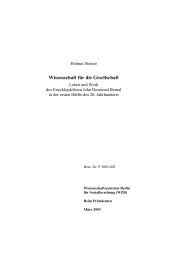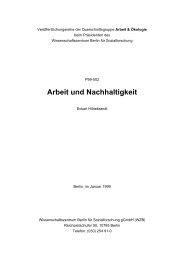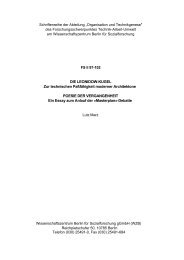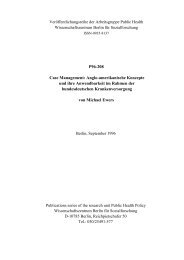New seminal environmental works. Nine review articles. - WZB
New seminal environmental works. Nine review articles. - WZB
New seminal environmental works. Nine review articles. - WZB
You also want an ePaper? Increase the reach of your titles
YUMPU automatically turns print PDFs into web optimized ePapers that Google loves.
4 <strong>New</strong> Seminal Environmental Works<br />
efforts to help the environment simply isn’t working. The design makes<br />
sure it won’t work, and the statistics keep getting worse. We need a new<br />
design, and to make that happen, civil society must take the helm” (p. xii).<br />
In four parts, Speth starts off to present such a new design by telling the<br />
story of how things got the way they are now – and how we can change<br />
them.<br />
Part I (pp. 11-73) is on how <strong>environmental</strong> challenges increasingly go<br />
global. He is presenting “A World of Wounds”, sweeping and disturbing<br />
evidence on the two mega trends of <strong>environmental</strong> degradation - industrial<br />
pollution and biological impoverishment - that occur in an increasingly<br />
fuller world. For such crucial issues as deforestation, loss of biodiversity,<br />
and climate change, he says, we have already run out of time. Speth is not<br />
quoting the Meadows at this point, but he makes it very clear: here, we are<br />
already beyond the limits. Instead, he is citing Dante’s notice at the en-<br />
trance of Hell: “Abandon all hope you who enter” (p. 11) and some of the<br />
statistics he is presenting are indeed hellish. Yet abandoning hope, he be-<br />
lieves, is precisely what we must not do: “However bad the situation looks,<br />
remember: there are solutions” (p. xiii) – better solutions than the ones dis-<br />
cussed and presented in the past.<br />
Thus, part II of the book (pp. 75–116) is a really fine <strong>review</strong> of the first at-<br />
tempts at global <strong>environmental</strong> governance. But no doubt, it is a <strong>review</strong> of<br />
an “Anatomy of Failure”. Given the magnitude of the challenges, the re-<br />
sponses mounted by the international community appear pitifully weak.<br />
Undoubtedly, international <strong>environmental</strong> affairs have become a major sub-<br />
ject of scholarly inquiry and teaching, a large body of relevant scholarship<br />
now exists – though only one <strong>environmental</strong> research was to win a Nobel<br />
prize so far (Rowland, Molina, Crutzen).
















